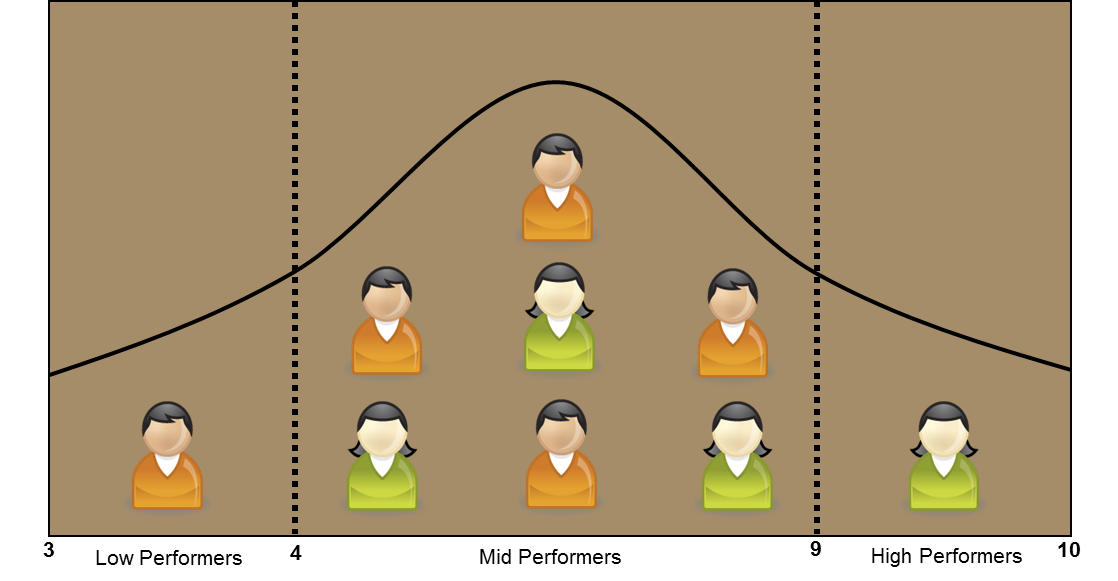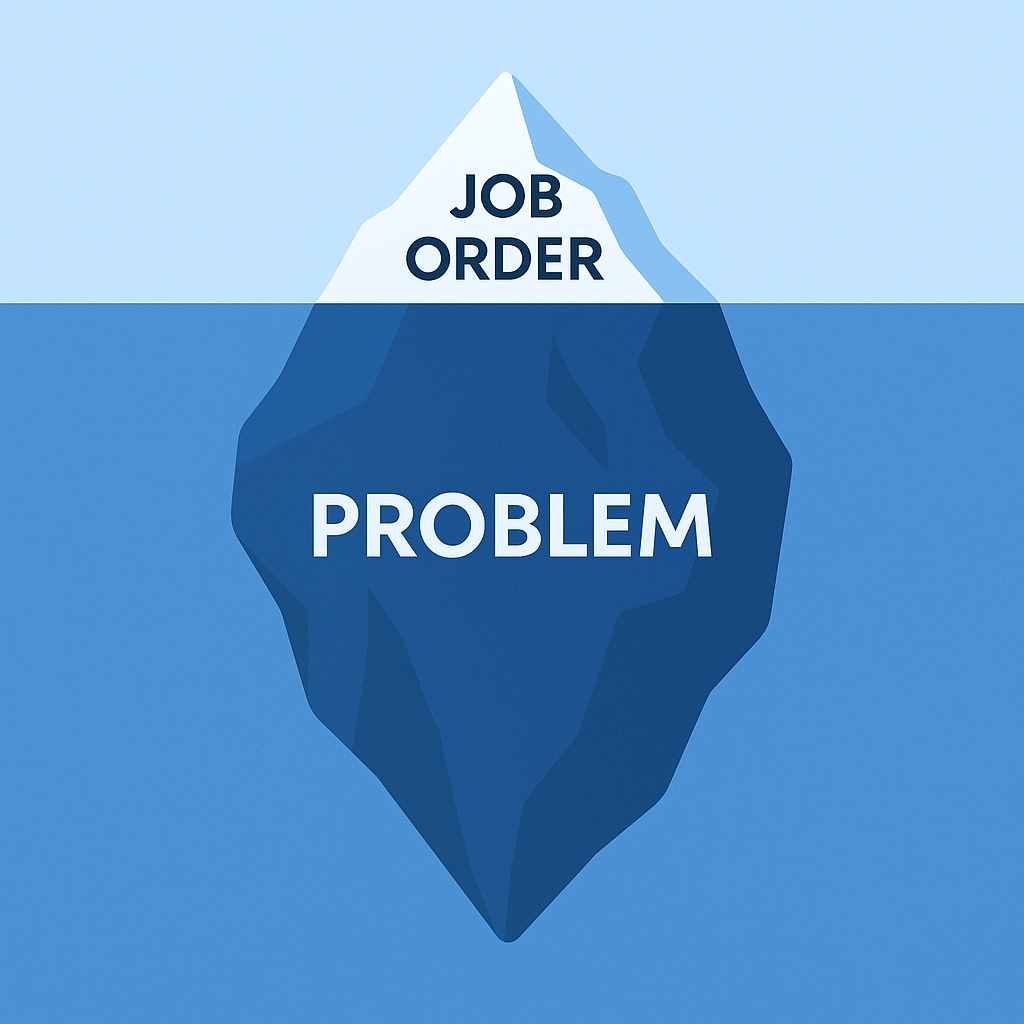Selling With Your Consultant
In my previous post, How to Prevent Unexpected Contract Terminations, I shared how systemizing consultant and client check-ins at key milestones...

As the new year quickly approaches, it's time for staffing leaders and CEO's to ensure they have the right strategy in place to scale for sales revenue growth in 2020. Scaling for growth is about replicating success across your organization and making it repeatable on a broader scale. It also means figuring out how to make successful sales onboarding repeatable, scalable and even predictable.
Chances are your existing sales team falls into a bell curve like you see in the illustration below. You're getting 80% of your revenue from from your top performers, likely just 10%-20% of your sales team. Meanwhile, 60% of your sales reps are only achieving 50%-70% of quota and the bottom 20% is really struggling just trying to figure things out.
The question becomes, how do you shift the bell curve to the right so that a higher percentage of your salesforce (including all new sales hires) are meeting and exceeding sales quota? In this blog post, how to scale for sales revenue in growth in 2020, I'm going to share with you best practices and worst practices for companies scaling for growth.

How NOT to Scale for Sales Revenue Growth
The most common misconception for scaling for sales revenue growth is organizations who think and believe "we just need to hire senior, experienced people. We're going to hire top performers." There are multiple flaws with this approach. First, finding and hiring senior, experienced people or top performers is not a scalable solution because there simply are not enough of them in the marketplace. Not only that, they can be very expensive to hire. Even if you do find a top performer, there is always going to be another company willing to pay more.
Second, and more importantly, this approach leaves success entirely up to the individual. Imagine what would have happened when McDonald's started back in the 1950's and each line cook hired was left to figure things out on their own and cook hamburgers the way in which they were comfortable cooking hamburgers? Do you think they would have achieved "68 million served?"
My point is, with no focus on sales process or sales methodology or sales coaching, you’re relying exclusively on hiring the “right” people to figure things out. This approach results in a salesforce that resembles the bell curve illustrated above in which each rep is trying to figure things out on their own and ends up selling in a way in which they're most comfortable. This leads to inconsistent messaging and inconsistent success rates across your sales team with no ability to replicate best practices and top performing sales behaviors.
Another common mistake when trying to scale for sales revenue growth is failure to validate the sales go-to-market strategy. What happens is an organization has success with selling a service to a certain buyer persona or industry vertical and then they try to replicate that success to a broader audience without first validating the sales go-to-market strategy including the messaging.
What got your company to where it is today will not get you to the next level. There is a big difference between individual sales sales success and replicating sales success across your entire salesforce. To scale your staffing business, you have to engage in and develop your sales process, sales methodology and sales enablement function. Even if your top performer is the best salesperson in the world, your revenue target will become to big for one person. At some point, 60% or more of your sales team needs to be hitting 80% of sales quota.
How to Scale for Sales Revenue Growth
Organizations that have figured out how to scale for sales revenue growth invest the time in defining "what excellence looks like." Those definitions become performance standards and are integrated into their sales culture making the message, methodology, process, and/or behavior part of what they do and how they do it.
To replicate sales success, the best organizations define "what excellence looks like" for each of the following:"
Keep in mind that to scale for growth you will need to take a step back, and take a step by step approach. It will likely take 30, 60 or even 90 days before you define what excellence looks like but the payback is massive. Taking the time to do it the right way and make the right investments will enable you to grow much faster over the long haul. That is was scalable sales revenue growth is all about; a long term strategy for sustainable, repeatable growth.
Let me share an example of what I mean by taking a step by step approach to define what excellence looks like. We have a sales training course titled, Accelerating the Customer Interviewing, Hiring and Buying Process. This course teaches salespeople best practices for accelerating the sales cycle including receiving timely (candidate interview) feedback from hiring managers (among other topics). To build one component of this training, I had to define the following:
Thinking through these details takes time and requires careful planning. BUT, this is how you replicate sales best practices. Defining these details and making it repeatable is the key to scalable growth. This is just one reason why our clients see a massive increase in profitability per sales rep and an increase in overall team quota attainment.
Finally, the most under emphasized and overlooked aspect of scaling for sales revenue growth is sales coaching. Simply put, sales managers need to consistently coach to the sales strategy and messaging. The quality and frequency of the manager's coaching conversations including the questions they ask is directly correlated to the organizations ability to scale. Managers who consistently engage in coaching conversations accelerate the organizations ability to scale.
Are you looking to scale for sales revenue in 2020 and beyond? If you are, let's start a conversation. I have years of experiencing in helping IT staffing firms scale for sales revenue growth.
For more onboarding tips, read our step-by-step guide to making successful sales onboarding repeatable and predictable.

In my previous post, How to Prevent Unexpected Contract Terminations, I shared how systemizing consultant and client check-ins at key milestones...

About a year ago, I was serving as the fractional revenue leader, managing sales and recruiting for a client.

If you’ve worked in staffing long enough, you’ve been trained to chase job orders.